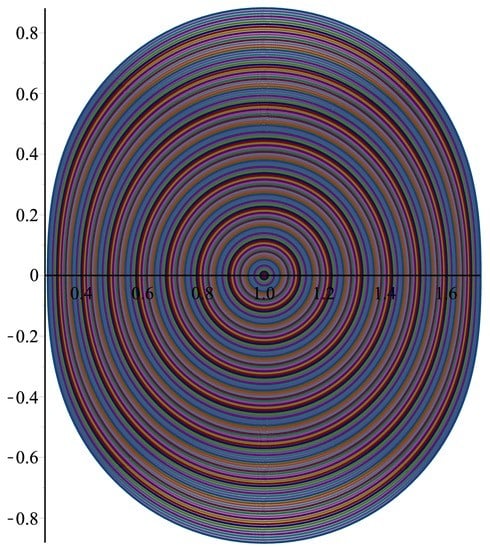Subordination Implications and Coefficient Estimates for Subclasses of Starlike Functions
Abstract
1. Introduction
2. Subordination Implications
3. The Classes and
4. Coefficient Estimates
5. Conclusions
Author Contributions
Funding
Acknowledgments
Conflicts of Interest
References
- Ma, W.C.; Minda, D. A unified treatment of some special classes of univalent functions. In Proceedings of the Conference on Complex Analysis, Tianjin, China, 19–23 June 1992; Internat Press: Cambridge, MA, USA, 1992; pp. 157–169. [Google Scholar]
- Sokół, J.; Stankiewicz, J. Radius of convexity of some subclasses of strongly starlike functions. Zesz. Nauk. Politech. Rzesz. Mat. 1996, 19, 101–105. [Google Scholar]
- Sokół, J. On some subclass of strongly starlike functions. Demonstr. Math. 1998, 21, 81–86. [Google Scholar]
- Cho, N.E.; Kumar, V.; Kumar, S.S.; Ravichandran, V. Radius problems for starlike functions associated with the sine function. Bull. Iranian Math. Soc. 2019, 45, 1–20. [Google Scholar] [CrossRef]
- Raina, R.K.; Sokół, J. Some properties related to a certain class of starlike functions. C. R. Acad. Sci. Paris 2015, 353, 973–978. [Google Scholar] [CrossRef]
- Kanas, S.; Masih, V.S.; Ebadian, A. Relations of a planar domains bounded by hyperbolas with families of holomorphic functions. J. Inequal. Appl. 2019, 2019, 246. [Google Scholar] [CrossRef]
- Alimohammadi, D.; Cho, N.E.; Adegani, E.A.; Motamednezhad, A. Argument and coefficient estimates for certain analytic functions. Mathematics 2020, 8, 88. [Google Scholar] [CrossRef]
- Ebadian, A.; Bulboacă, T.; Cho, N.E.; Adegani, E.A. Coefficient bounds and differential subordinations for analytic functions associated with starlike functions. Rev. R. Acad. Cienc. Exactas Fís. Nat. Ser. A Mat. 2020, 114, 128. [Google Scholar] [CrossRef]
- Srivastava, H.M. Operators of basic (or q-) calculus and fractional q-calculus and their applications in geometric function theory of complex analysis. Iran J. Sci. Technol. Trans. Sci. 2020, 44, 327–344. [Google Scholar] [CrossRef]
- Srivastava, H.M.; Bilal, K.H.A.N.; Nazar, K.H.A.N.; Ahmad, Q.Z. Coefficient inequalities for q-starlike functions associated with the Janowski functions. Hokkaido Math. J. 2019, 48, 407–425. [Google Scholar] [CrossRef]
- Srivastava, H.M.; Tahir, M.; Khan, B.; Ahmad, Q.Z.; Khan, N. Some general families of q-starlike functions associated with the Janowski functions. Filomat 2019, 33, 2613–2626. [Google Scholar] [CrossRef]
- Srivastava, H.M.; Tahir, M.; Khan, B.; Ahmad, Q.Z.; Khan, N. Some general classes of q-starlike functions associated with the Janowski functions. Symmetry 2019, 11, 292. [Google Scholar] [CrossRef]
- Ebadian, A.; Cho, N.E.; Adegani, E.A.; Bulut, S.; Bulboacă, T. Radii problems for some classes of analytic functions associated with Legendre polynomials of odd degree. J. Inequal. Appl. 2020, 2020, 178. [Google Scholar] [CrossRef]
- Milovanović, G.V.; Rassias, M.T. (Eds.) Analytic Number Theory, Approximation Theory and Special Functions-In Honor of Hari M. Srivastava; Springer: Berlin/Heidelberg, Germany, 2014. [Google Scholar]
- Murugusundaramoorthy, G.; Magesh, N. Starlike and convex functions of complex order involving the Dziok-Srivastava operator. Integr. Transform. Spec. Funct. 2007, 18, 419–425. [Google Scholar] [CrossRef]
- Ponnusamy, S. Close-to-convexity properties of Gaussian hypergeometric functions. J. Comput. Appl. Math. 1997, 88, 327–337. [Google Scholar] [CrossRef]
- Srivastava, H.M.; Aouf, M.K.; Mostafa, A.O. Some properties of analytic functions associate with fractional-calculus operators. Miskolc Math. Notes 2019, 20, 1245–1260. [Google Scholar] [CrossRef]
- Ali, R.M.; Ravichandran, V.; Lee, S.K. Subclasses of multivalent starlike and convex functions. Bull. Belg. Math. Soc. Simon Stevin 2009, 16, 385–394. [Google Scholar] [CrossRef]
- Kargar, R.; Ebadian, A.; Sokół, J. Radius problems for some subclasses of analytic functions. Complex Anal. Oper. Theory 2017, 11, 1639–1649. [Google Scholar] [CrossRef]
- Sun, Y.; Wang, Z.-G.; Rasila, A.; Sokół, J. On a subclass of starlike functions associated with a vertical strip domain. J. Ineq. Appl. 2019, 2019, 35. [Google Scholar] [CrossRef]
- Yanga, D.-G.; Liu, J.-L. Argument inequalities for certain analytic functions. Math. Comput. Model. 2010, 52, 1812–1821. [Google Scholar] [CrossRef]
- Kargar, R.; Sokół, J.; Mahzoon, H. Some properties of a certain subclass of strongly starlike functions. arXiv 2018, arXiv:1811.01271. [Google Scholar]
- Duren, P.L. Univalent Functions. Grundlehren der Mathematischen Wissenschaften; Springer: Berlin/Heidelberg, Germany, 1983; Volume 259. [Google Scholar]
- Ruscheweyh, S. A subordination theorem for Φ-like functions. J. London Math. Soc. 1976, 13, 275–280. [Google Scholar] [CrossRef]
- Adegani, E.A.; Cho, N.E.; Jafari, M. Logarithmic coefficients for univalent functions defined by subordination. Mathematics 2019, 7, 408. [Google Scholar] [CrossRef]
- Piejko, K.; Sokół, J. Hadamard product of analytic functions and some special regions and curves. J. Inequal. Appl. 2013, 2013, 420. [Google Scholar] [CrossRef]
- Kargar, R.; Ebadian, A.; Sokół, J. On Booth lemniscate and starlike functions. Anal. Math. Phys. 2019, 9, 143–154. [Google Scholar] [CrossRef]
- Kuroki, K.; Owa, S. Notes on new class for certain analytic functions. RIMS Kokyuroku 2011, 1772, 21–25. [Google Scholar]
- Sun, Y.; Jiang, Y.-P.; Rasila, A.; Srivastava, H.M. Integral representations and coefficient estimates for a subclass of meromorphic starlike functions. Complex Anal. Oper. Theory 2017, 11, 1–19. [Google Scholar] [CrossRef]
- Xu, Q.H.; Gui, Y.C.; Srivastava, H.M. Coefficient estimates for certain subclasses of analytic functions of complex order. Taiwan. J. Math. 2011, 15, 2377–2386. [Google Scholar] [CrossRef]
- Sim, Y.J.; Kwon, O.S. Certain subclasses of meromorphically bi-univalent functions. Bull. Malays. Math. Sci. Soc. 2017, 40, 841–855. [Google Scholar] [CrossRef]

© 2020 by the authors. Licensee MDPI, Basel, Switzerland. This article is an open access article distributed under the terms and conditions of the Creative Commons Attribution (CC BY) license (http://creativecommons.org/licenses/by/4.0/).
Share and Cite
Cho, N.E.; Ebadian, A.; Bulut, S.; Analouei Adegani, E. Subordination Implications and Coefficient Estimates for Subclasses of Starlike Functions. Mathematics 2020, 8, 1150. https://doi.org/10.3390/math8071150
Cho NE, Ebadian A, Bulut S, Analouei Adegani E. Subordination Implications and Coefficient Estimates for Subclasses of Starlike Functions. Mathematics. 2020; 8(7):1150. https://doi.org/10.3390/math8071150
Chicago/Turabian StyleCho, Nak Eun, Ali Ebadian, Serap Bulut, and Ebrahim Analouei Adegani. 2020. "Subordination Implications and Coefficient Estimates for Subclasses of Starlike Functions" Mathematics 8, no. 7: 1150. https://doi.org/10.3390/math8071150
APA StyleCho, N. E., Ebadian, A., Bulut, S., & Analouei Adegani, E. (2020). Subordination Implications and Coefficient Estimates for Subclasses of Starlike Functions. Mathematics, 8(7), 1150. https://doi.org/10.3390/math8071150





